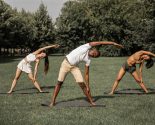
Exercising Together Can Strengthen Bonds with Family and Partners
Exercise is widely recognized as an essential part of a healthy lifestyle, but its benefits go beyond just physical and mental well-being. Engaging in physical activities with family members or partners can foster stronger relationships, improve communication, and enhance emotional connections. In today’s fast-paced world, where daily responsibilities and digital distractions can limit quality time spent together, exercising as a group or a couple provides an opportunity to bond while staying active. This article explores how exercising together strengthens relationships, the types of activities that are best suited for families and couples, and tips for making fitness a shared experience.
Strengthening Emotional Bonds Through Exercise
Physical activity releases endorphins, also known as “feel-good hormones,” which reduce stress and improve mood. When people exercise together, they share these positive experiences, creating a sense of teamwork and mutual support. Whether it is a morning jog, a weekend hike, or a family bike ride, these moments encourage deeper emotional connections. Studies have shown that couples who work out together feel more satisfied in their relationships, while families who engage in group activities tend to have better communication and mutual understanding.
Exercising together also promotes accountability and motivation. A partner or family member can serve as a source of encouragement, helping to maintain consistency in workout routines. This shared commitment not only benefits individual health but also strengthens the sense of unity within the relationship.
Types of Exercises for Families and Couples
Different types of physical activities can enhance relationships, depending on preferences and fitness levels. Here are some ideal activities that promote bonding:
- Outdoor Activities: Activities such as hiking, cycling, or running provide an opportunity to enjoy nature while engaging in conversation. These activities are particularly effective for families with children, as they encourage exploration and teamwork.
- Sports and Games: Playing basketball, soccer, or tennis together can be both fun and physically rewarding. Competitive yet friendly games build trust, cooperation, and strategic thinking skills.
- Yoga and Meditation: Practicing yoga or meditation together helps create a sense of peace and relaxation. This is particularly beneficial for couples who want to improve their emotional connection and reduce stress.
- Dance Workouts: Dancing together, whether through structured dance classes or spontaneous movements at home, can bring joy and strengthen intimacy, making it an ideal activity for partners.
- Strength Training and Gym Workouts: For couples or family members who enjoy a structured fitness routine, going to the gym or engaging in strength training sessions can build physical endurance while providing opportunities for encouragement and teamwork.
Tips for Making Exercise a Shared Experience
To fully enjoy the benefits of exercising together, it is important to create a sustainable and enjoyable routine. Here are some practical tips:
- Set Common Goals: Establish fitness goals that align with the interests and abilities of all participants. Whether it is weight management, stress relief, or simply spending more quality time together, having a shared objective increases motivation.
- Be Supportive and Encouraging: Avoid criticism and instead focus on positive reinforcement. Celebrate small achievements and progress to maintain enthusiasm.
- Schedule Regular Workouts: Consistency is key. Designating specific times for exercise, such as weekend outings or evening walks, helps build a long-term habit.
- Mix Up Activities: Trying different activities keeps exercise fun and engaging. Changing routines prevents boredom and ensures that everyone remains excited about staying active.
- Respect Individual Differences: Not everyone has the same fitness level or interest. Adjusting the intensity and type of exercise to accommodate each participant makes the experience enjoyable for all.
Conclusion
Exercising together is not just about staying fit—it is a meaningful way to strengthen relationships, enhance communication, and create lasting memories. Whether with a partner or family members, engaging in shared physical activities fosters teamwork, improves emotional well-being, and reinforces mutual support. By making fitness a joint endeavor, families and couples can build healthier, happier relationships while enjoying the numerous benefits of an active lifestyle.





